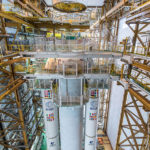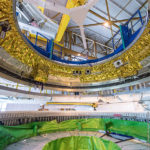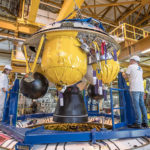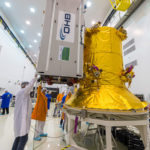The Ariane 5 for Arianespace’s December 12 year-ending flight for 2017 has completed its initial build-up at the Spaceport in French Guiana – where preparations also are moving ahead with four satellite passengers that will further expand Europe’s Galileo global navigation system once in their final orbit.
During activity in the Spaceport’s Launcher Integration Building, this heavy-lift vehicle for Arianespace Flight VA240 underwent the assembly process that began by mating its two solid propellant strap-on boosters with the main cryogenic stage.
The next step was integration of Ariane 5’s vehicle equipment bay, which serves as the launch vehicle’s “brain,” providing autonomous control during the various mission phases.
The Ariane 5 ES difference
It was followed by installation of the EPS storable propellant stage, powered by a re-ignitable engine that operates with MMH and N2O4 propellants. This differentiates the Ariane 5 ES configuration from Arianespace’s Ariane 5 ECA version – which has a cryogenic upper stage and typically is used on Arianespace missions with telecommunications satellites to geostationary transfer orbits.
After completion of verifications and systems checkout by production prime contractor ArianeGroup, the Ariane 5 ES launch vehicle will be moved to the Spaceport’s Final Assembly Building for payload integration and readiness for rollout to the launch zone.
The mission’s ongoing payload preparations – which so far included the checkout and fit-check procedure for each of the four Galileo satellites – took place inside the Spaceport’s S1A processing facility. This involved a one-by-one verification of the spacecraft’s interface with the payload dispenser that will release them into circular orbit during the mission.
Galileo satellites checked… and fit
After the fit-check procedure in the S1A facility, the four satellites were readied for transfer to the S3B payload preparation center for fueling.
For Ariane 5’s December 12 mission, the heavy-lift vehicle will carry its quartet of Galileo satellites (weighing approximately 715 kg. each) and their dispenser system for a medium-Earth orbit deployment.
Ariane 5’s mission with the four Galileo spacecraft will close out a busy year of launch activity for Arianespace, which has performed 10 missions from French Guiana so far in 2017 – all of which were successful. The flights to date involved five launches of the heavy-lift Ariane 5, two with the medium Soyuz and three with the lightweight Vega.




